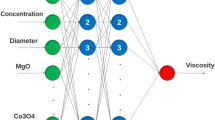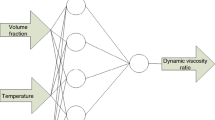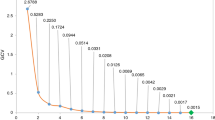Abstract
This study designs and develops a new optimised deep learning method to calculate the dynamic viscosity using the temperature and nanoflake concentration. Long short-term memory (LSTM) has been a candidate as the most suitable deep learning method with the ability to reach higher accurate results with a definition of the dropout layers during the training process to prevent the overshoot issue of the networks. In addition, the Bayesian optimisation technique is employed to extract the optimal hyperparameters of the developed LSTM to reach the system’s highest performance in predicting the dynamical viscosity based on temperature and nanoflake concentration. The newly proposed method is designed and developed in MATLAB software using 80% and 20% of the dataset for training and testing of the model. The newly proposed optimised LSTM is compared with the recently developed model using multilayer perceptron (MLP) to prove the higher efficiency of our proposed technique. It should be noted that mean-squared error and root-mean-square error using the newly proposed optimised LSTM reduce by 12.56 and 3.54 times compared to the recently developed MLP model. Also, the R-square of the newly proposed optimised LSTM increases by 4.43% compared to the recently developed MLP model.










Similar content being viewed by others
References
Choi SU, Eastman JA (1995) Enhancing thermal conductivity of fluids with nanoparticles. Argonne National Lab, Argonne, IL
Wang F, Han L, Zhang Z, Fang X, Shi J, Ma W (2012) Surfactant-free ionic liquid-based nanofluids with remarkable thermal conductivity enhancement at very low loading of graphene. Nanoscale Res Lett 7(1):1–7
Okonkwo EC, Wole-Osho I, Almanassra IW, Abdullatif YM, Al-Ansari T (2021) An updated review of nanofluids in various heat transfer devices. J Therm Anal Calorim 145(6):2817–2872
Elsaid K et al (2021) Thermophysical properties of graphene-based nanofluids. Int J Thermofluids 10:100073
Karthikeyan N, Philip J, Raj B (2008) Effect of clustering on the thermal conductivity of nanofluids. Mater Chem Phys 109(1):50–55
Ali N, Bahman AM, Aljuwayhel NF, Ebrahim SA, Mukherjee S, Alsayegh A (2021) Carbon-based nanofluids and their advances towards heat transfer applications—a review. Nanomaterials 11(6):1628
Karami H et al (2019) The thermophysical properties and the stability of nanofluids containing carboxyl-functionalized graphene nano-platelets and multi-walled carbon nanotubes. Int Commun Heat Mass Transfer 108:104302
Shahzad F, Zaidi SA, Naqvi RA (2020) 2D transition metal carbides (MXene) for electrochemical sensing: a review. Crit Rev Anal Chem 52:848–864
Xia G, Jiang H, Liu R, Zhai Y (2014) Effects of surfactant on the stability and thermal conductivity of Al2O3/de-ionized water nanofluids. Int J Therm Sci 84:118–124
Ali F, Khan I, Sheikh NA, Gohar M, Tlili I (2018) Effects of different shaped nanoparticles on the performance of engine-oil and kerosene-oil: a generalized Brinkman-type fluid model with non-singular kernel. Sci Rep 8(1):1–13
Sedeh RN, Abdollahi A, Karimipour A (2019) Experimental investigation toward obtaining nanoparticles’ surficial interaction with basefluid components based on measuring thermal conductivity of nanofluids. Int Commun Heat Mass Transfer 103:72–82
Ahmadi MH, Mirlohi A, Nazari MA, Ghasempour R (2018) A review of thermal conductivity of various nanofluids. J Mol Liq 265:181–188
Kilic M, Ullah A (2021) Numerical investigation of effect of different parameter on heat transfer for a crossflow heat exchanger by using nanofluids. J Thermal Eng 7(Supp 14):1980–1989
Madderla S, Ramasamy D, Sudhakar K, Kadirgama K, Harun WSW (2021) Heat transfer performance of a radiator with and without louvered strip by using Graphene-based nanofluids. J Thermal Eng 7(6):1315–1328
Kim SC, Poongavanam G, Duraisamy S, Parasuraman S, Megaraj M (2022) Experimental investigations of stability, density, thermal conductivity, and electrical conductivity of solar glycol-amine-functionalized graphene and MWCNT-based hybrid nanofluids. Environ Sci Pollut Res 29(6):8731–8745
Meikandan M, Malarmohan K, Hemachandran E (2019) Experimental investigation on thermal performance of nanocoated surfaces for air-conditioning applications. Thermal Sci 23(2):457–463
Ariana M, Vaferi B, Karimi G (2015) Prediction of thermal conductivity of alumina water-based nanofluids by artificial neural networks. Powder Technol 278:1–10
Esfe MH, Ahangar MRH, Rejvani M, Toghraie D, Hajmohammad MH (2016) Designing an artificial neural network to predict dynamic viscosity of aqueous nanofluid of TiO2 using experimental data. Int Commun Heat Mass Transfer 75:192–196
Sheikholeslami M, Gerdroodbary MB, Moradi R, Shafee A, Li Z (2019) Application of neural network for estimation of heat transfer treatment of Al2O3-H2O nanofluid through a channel. Comput Methods Appl Mech Eng 344:1–12
Li L, Zhai Y, Jin Y, Wang J, Wang H, Ma M (2020) Stability, thermal performance and artificial neural network modeling of viscosity and thermal conductivity of Al2O3-ethylene glycol nanofluids. Powder Technol 363:360–368
He W et al (2020) Using of artificial neural networks (ANNs) to predict the thermal conductivity of zinc oxide–silver (50%–50%)/water hybrid Newtonian nanofluid. Int Commun Heat Mass Transfer 116:104645
Mukesh Kumar P, Kavitha R (2021) Prediction of nanofluid viscosity using multilayer perceptron and Gaussian process regression. J Thermal Anal Calorim 144(4):1151–1160
Rostami S, Toghraie D, Shabani B, Sina N, Barnoon P (2021) Measurement of the thermal conductivity of MWCNT-CuO/water hybrid nanofluid using artificial neural networks (ANNs). J Therm Anal Calorim 143(2):1097–1105
HemmatEsfe M, Motallebi SM (2021) Optimization, modeling, and prediction of relative viscosity and relative thermal conductivity of AlN nano-powders suspended in EG. Eur Phys J Plus 136(1):1–19
Mirsaeidi A, Yousefi F (2021) Viscosity, thermal conductivity and density of carbon quantum dots nanofluids: an experimental investigation and development of new correlation function and ANN modeling. J Therm Anal Calorim 143(1):351–361
Zhao N, Li Z (2017) Experiment and artificial neural network prediction of thermal conductivity and viscosity for alumina-water nanofluids. Materials 10(5):552
Komeilibirjandi A, Raffiee AH, Maleki A, Alhuyi Nazari M, Safdari Shadloo M (2020) Thermal conductivity prediction of nanofluids containing CuO nanoparticles by using correlation and artificial neural network. J Thermal Anal Calorim 139(4):2679–2689
Sadeghzadeh M et al (2020) Prediction of thermo-physical properties of TiO2-Al2O3/water nanoparticles by using artificial neural network. Nanomaterials 10(4):697
Parashar N, Khan J, Aslfattahi N, Saidur R, Yahya SM (2022) Prediction of the dynamic viscosity of MXene/Palm oil nanofluid using support vector regression. In: Recent trends in thermal engineering, Springer, 49–55
Said Z, Sharma P, Aslfattahi N, Ghodbane M (2022) Experimental analysis of novel ionic liquid-MXene hybrid nanofluid’s energy storage properties: Model-prediction using modern ensemble machine learning methods. J Energy Storage 52:104858
Esfe MH et al (2017) Optimization, modeling and accurate prediction of thermal conductivity and dynamic viscosity of stabilized ethylene glycol and water mixture Al2O3 nanofluids by NSGA-II using ANN. Int Commun Heat Mass Transfer 82:154–160
Amani M, Amani P, Kasaeian A, Mahian O, Pop I, Wongwises S (2017) Modeling and optimization of thermal conductivity and viscosity of MnFe2O4 nanofluid under magnetic field using an ANN. Sci Rep 7(1):1–13
Adun H, Wole-Osho I, Okonkwo EC, Bamisile O, Dagbasi M, Abbasoglu S (2020) A neural network-based predictive model for the thermal conductivity of hybrid nanofluids. Int Commun Heat Mass Transfer 119:104930
Bamidele EA et al (2022) Discovery and prediction capabilities in metal-based nanomaterials: An overview of the application of machine learning techniques and some recent advances. Adv Eng Inform 52:101593
Wang X et al (2023) Deep reinforcement learning-PID based supervisor control method for indirect-contact heat transfer processes in energy systems. Eng Appl Artif Intell 117:105551
Rubbi F, Habib K, Saidur R, Aslfattahi N, Yahya SM, Das L (2020) Performance optimization of a hybrid PV/T solar system using Soybean oil/MXene nanofluids as A new class of heat transfer fluids. Sol Energy 208:124–138
Rosenblatt F (1957) The perceptron, a perceiving and recognizing automaton Project Para. Cornell Aeronautical Laboratory, New York
Hastie T, Tibshirani R, Friedman J (2009) The elements of statistical learning: data mining, inference, and prediction. Springer Science & Business Media, Berlin
Hochreiter S, Schmidhuber J (1997) Long short-term memory. Neural Comput 9(8):1735–1780
Longenecker RN (2015) Paul, apostle of liberty. Wm B Eerdmans Publishing, Grand Rapids
Pelikan M, Goldberg DE, Cantú-Paz E (1999) BOA: the bayesian optimization algorithm. In: Proceedings of the genetic and evolutionary computation conference GECCO-99, Citeseer, vol 1, pp 525–532
Parashar N, Aslfattahi N, Yahya SM, Saidur R (2021) An artificial neural network approach for the prediction of dynamic viscosity of MXene-palm oil nanofluid using experimental data. J Therm Anal Calorim 144(4):1175–1186
Funding
This study was self-funded.
Author information
Authors and Affiliations
Contributions
MRCQ performed conceptualisation, methodology, software, validation, formal analysis, investigation, data curation, writing–original draft, writing-review & editing, visualisation, supervision, and project administration; NA did conceptualisation, methodology, software, validation, formal analysis, investigation, data curation, writing–original draft, writing-review & editing, visualization, supervision, and project administration; VK gave writing– review & editing; houshyar asadi provided writing–review & editing, validation, and formal analysis; MS done writing–review & editing; ZS done writing–review & editing, supervision, and project administration; DK contributed writing–review & editing; MA did writing–review & editing.
Corresponding authors
Ethics declarations
Conflict of interest
There are no conflicts of interest.
Additional information
Technical Editor: Ahmad Arabkoohsar.
Publisher's Note
Springer Nature remains neutral with regard to jurisdictional claims in published maps and institutional affiliations.
Rights and permissions
Springer Nature or its licensor (e.g. a society or other partner) holds exclusive rights to this article under a publishing agreement with the author(s) or other rightsholder(s); author self-archiving of the accepted manuscript version of this article is solely governed by the terms of such publishing agreement and applicable law.
About this article
Cite this article
Qazani, M.R.C., Aslfattahi, N., Kulish, V. et al. An optimised deep learning method for the prediction of dynamic viscosity of MXene-based nanofluid. J Braz. Soc. Mech. Sci. Eng. 45, 428 (2023). https://doi.org/10.1007/s40430-023-04284-w
Received:
Accepted:
Published:
DOI: https://doi.org/10.1007/s40430-023-04284-w




